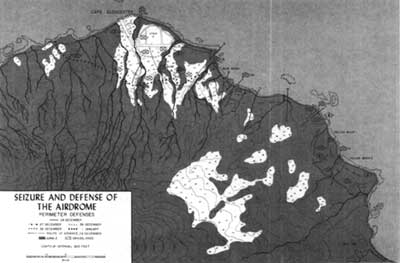| Marines in World War II Commemorative Series |
|
Cape Gloucester: The Green Inferno by Bernard C. Nalty Two Secondary Landings The first subsidiary landing took place on 15 December 1943 at distant Cape Merkus, across the Arawe channel from the islet of Arawe. Although it had a limited purpose—disrupting the movement of motorized barges and other small craft that moved men and supplies along the southern coast of New Britain and diverting attention from Cape Gloucester—it nevertheless encountered stiff resistance. Marine amphibian tractor crews used both the new, armored Buffalo and the older, slower, and more vulnerable Alligator to carry soldiers of the 112th Cavalry, who made the main landings on Orange Beach at the western edge of Cape Merkus. Fire from the destroyer USS Conyngham, supplemented by rocket-equipped DUKWs and a submarine chaser that doubled as a control craft, and a last-minute bombing by B-25s silenced the beach defenses and enabled the Buffaloes to crush the surviving Japanese machine guns that survived the naval and aerial bombardment. Less successful were two diversionary landings by soldiers paddling ashore in rubber boats. Savage fire forced one group to turn back short of its objective east of Orange Beach, but the other gained a lodgment on Pilelo Island and killed the handful of Japanese found there. An enemy airman had reported that the assault force was approaching Cape Merkus, and fighters and bombers from Rabaul attacked within two hours of the landing. Sporadic air strikes continued throughout December, although with diminishing ferocity, and the Japanese shifted troops to meet the threat in the south.
The other secondary landing took place on the morning of 26 December. The 1,500-man Stoneface Group—designated Battalion Landing Team 21 and built around the 2d Battalion, 1st Marines, under Lieutenant Colonel James M. Masters, Sr.—started toward Green Beach, supported by 5-inch gunfire from the American destroyers Reid and Smith. LCMs [Landing Craft, Medium] carried DUKW amphibian trucks, driven by soldiers and fitted with rocket launchers. The DUKWs opened fire from the landing craft as the assault force approached the beach, performing the same function as the rocket-firing LCIs at the Yellow Beaches on the opposite side of the peninsula. The first wave landed at 0748, with two others following it ashore. The Marines encountered no opposition as they carved out a beachhead 1,200 yards wide and extending 500 yards inland. The Stoneface Group had the mission of severing the coastal trail that passed just west of Mount Talawe, thus preventing the passage of reinforcements to the Cape Gloucester airfields. The trail net proved difficult to find and follow. Villagers cleared garden plots, tilled them until the jungle reclaimed them, and then abandoned the land and moved on, leaving a maze of trails, some faint and others fresh, that led nowhere. The Japanese were slow, however, to take advantage of the confusion caused by the tangle of paths. Not until the early hours of 30 December, did the enemy attack the Green Beach force. Taking advantage of heavy rain that muffled sounds and reduced visibility, the Japanese closed with the Marines, who called down mortar fire within 15 yards of their defensive wire. A battery of the 11th Marines, reorganized as an infantry unit because the cannoneers could not find suitable positions for their 75mm howitzers, shored up the defenses. One Marine in particular, Gunnery Sergeant Guiseppe Guilano, Jr., seemed to materialize at critical moments, firing a light machine gun from the hip; his heroism earned him the Navy Cross. Some of the Japanese succeeded in penetrating the position, but a counterattack led by First Lieutenant Jim G. Paulos of Company G killed them or drove them off. The savage fighting cost Combat Team 21 six Marines killed and 17 wounded; at least 89 Japanese perished, and five surrendered. On 11 January 1944, the reinforced battalion set out to rejoin the division, the troops moving overland, the heavy equipment and the wounded traveling in landing craft.
|



